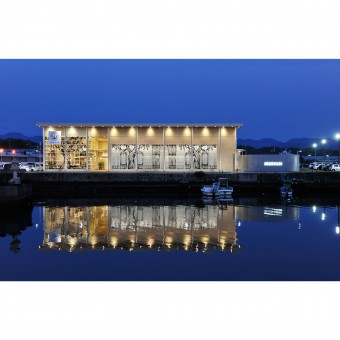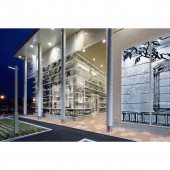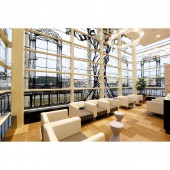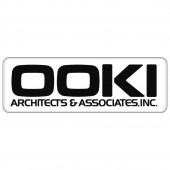Museum Commercial Building by Hiromoto Oki |
Home > Winners > #100289 |
 |
|
||||
| DESIGN DETAILS | |||||
| DESIGN NAME: Museum PRIMARY FUNCTION: Commercial Building INSPIRATION: Inspired by the surface of the water and environmental issues around the sea, the architect has designed a work that stands with people who live with the sea and the quayside area of a town, Tanabe. UNIQUE PROPERTIES / PROJECT DESCRIPTION: From a boat, this quayside building seems to float on the sea, and from a car, it gives the incredible impression of swaying, so that it is intimately linked with the visual qualities of the marine environment. The impression of swaying takes place because a glass wall and the inner solid wall have different design properties, and as a consequence create this unlikely but beautiful effect. The facility aims to be both a centre of culture in Tanabe and also to provide a vital area for recreation. OPERATION / FLOW / INTERACTION: The front entrance leads to the main hall, and shops are lined up along with the hallway. For the sea side entrance, it is characterized by wood-painted glass art, terracotta facades and thin columns, and on the left hand side, there is a path to the lounge that provides a relaxation space for visitors. PROJECT DURATION AND LOCATION: project duration: 2016 - 2017, location: Tanabe, Wakayama, Japan FITS BEST INTO CATEGORY: Architecture, Building and Structure Design |
PRODUCTION / REALIZATION TECHNOLOGY: structure: steel, material: terracotta, glass, aluminium SPECIFICATIONS / TECHNICAL PROPERTIES: total floor area: 977.45m2, width: 27.5m, length: 36.2m, height: 9m TAGS: Commercial building, waterfront, quayside, glass RESEARCH ABSTRACT: We arrived at this design that embraces the waterfront environment and nature around it after researching the historical background of Mori Bay, its importance for the local community, and the characteristics of buildings around the bay. In the area, the construction of the wharf started in 1934. It was the very first step that made the small local bay into the gateway to the sea for the whole city of Tanabe. Unfortunately, the port was severely damaged during the Nankai Earthquake in 1946; however, it has been restored by local citizens’ efforts and improved one after another. Thus, it has been developed as an essential port that handles and supports local industries such as lumber, gravel, and sand. In order to stand in the middle of nature around it and at the heart of local people’s life, the design direction was carefully chosen to reflect the environment and welcome the local communities. CHALLENGE: The building has an amazing view of a bay and a world heritage, Kumano Kodo (part of Sacred Sites and Pilgrimage Routes in the Kii Mountain Range). The major challenges of this project were to coexist with nature and to have positive effects on marine activities and the waterfront without spoiling the landscape. The facade has warm terracotta, wood-painted glass art, and thin columns; and it creates a sense of unity with nature. This effect creates the impression that the building naturally stands in the scenery. ADDED DATE: 2020-02-23 21:34:20 TEAM MEMBERS (1) : IMAGE CREDITS: OOKI Architects & Associates |
||||
| Visit the following page to learn more: http://ookikenchiku.co.jp/museun/ | |||||
| AWARD DETAILS | |
 |
Museum Commercial Building by Hiromoto Oki is Winner in Architecture, Building and Structure Design Category, 2019 - 2020.· Read the interview with designer Hiromoto Oki for design Museum here.· Press Members: Login or Register to request an exclusive interview with Hiromoto Oki. · Click here to register inorder to view the profile and other works by Hiromoto Oki. |
| SOCIAL |
| + Add to Likes / Favorites | Send to My Email | Comment | Testimonials | View Press-Release | Press Kit | Translations |
Did you like Hiromoto Oki's Architecture Design?
You will most likely enjoy other award winning architecture design as well.
Click here to view more Award Winning Architecture Design.








